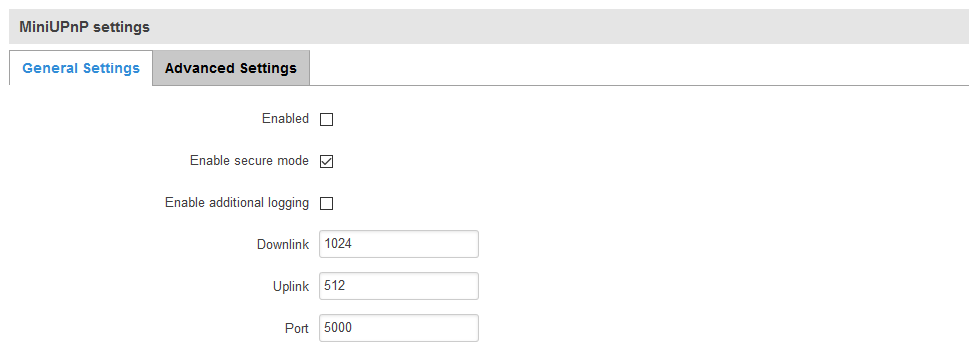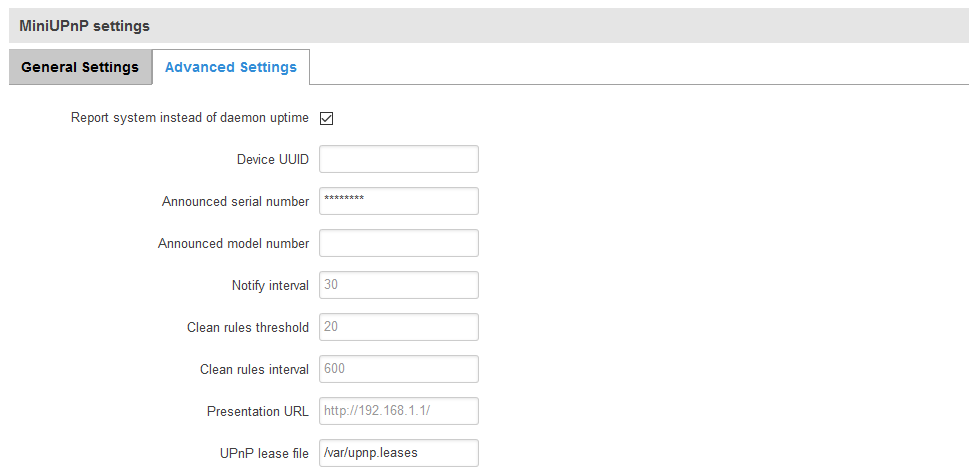RUT230 UPNP (legacy WebUI): Difference between revisions
Gytispieze (talk | contribs) (Created page with "{{Template: Networking_rut_manual_upnp_legacy <!------------------------DEVICE-----------------------> | name = RUT230 | series = RUT2XX }}") |
Gytispieze (talk | contribs) m (Gytispieze moved page Draft:RUT230 UPNP (legacy WebUI) to RUT230 UPNP (legacy WebUI) without leaving a redirect) |
| (One intermediate revision by the same user not shown) | |
(No difference)
| |
Latest revision as of 13:17, 18 November 2021
Main Page > EOL Products > RUT230 > RUT230 Manual > RUT230 Legacy WebUI > RUT230 Services section (legacy) > RUT230 UPNP (legacy WebUI)The information in this page is updated in accordance with firmware version RUT2XX_R_00.01.14.7.
Notice: This device has entered it's EOL (End of Life) cycle. For more information, visit our EOL policy here. Temporarily, some content in this page might not match features found in firmware listed above.
Note: this user manual page is for RUT230's old WebUI style available in earlier FW versions. Click here for information based on the latest FW version.
Summary
UPnP (Universal Plug and Play) is a service that allows clients in the local network to automatically configure some devices and services.
This chapter of the user manual provides an overview of the UPnP page in RUT230 devices.
UPnP is additional software that can be installed from the System → Package Manager page.
Active UPnP Redirects
In this table you can see all currently active UPnP redirects.
General Settings
| Field | Value | Description |
|---|---|---|
| Enabled | yes | no; default: no | Toggles UPnP on or off. |
| Enable secure mode | yes | no; default: yes | Toggles secure mode on or off. |
| Enable additional logging | yes | no; default: no | Puts extra debugging information into the system log. |
| Downlink | integer; default: 1024 | Bandwidth available for traffic coming in from the external interface in kbit/s. Note that this only information given to clients, it doesn't control the speed. In order to control the speed, you can try configuring QoS. |
| Uplink | integer; default: 512 | Bandwidth available for traffic out the external interface in kbit/s. Note that this only information given to clients, it doesn't control the speed. In order to control the speed, you can try configuring QoS. |
| Port | integer [1..65535]; default: 5000 | Port to listen for requests. |
Advanced Settings
| Field | Value | Description |
|---|---|---|
| Report system instead of daemon uptime | yes | no; default: yes | Use system uptime as UPnP uptime. |
| Device UUID | string; default: unique | The Device UUID attribute specifies and uniquely identifies a device that supports Universal Plug and Play (UPnP). |
| Announced serial number | string; Default: none | Specifies serial number for XML Root Desc. |
| Announced model number | string; Default: none | Specifies model number for XML Root Desc. |
| Notify interval | integer; Default: none | Interval in which UPnP capable devices send a message to announce their services. |
| Clean ruler threshold | integer; Default: none | Minimum number of redirections before clearing rules table of old (active) redirections. |
| Clean ruler interval | integer; Default: none | Number of seconds before cleaning redirections. |
| Presentation URL | string; Default: none | Presentation url used for the Root Desc. |
| UPnP lease file | string; default: /var/upnp.leases | Stores active UPnP redirects in a lease file (specified), like DHCP leases. |
UPnP ACLs
ACLs specify which external ports may be redirected to which internal addresses and ports. There are two preconfigured rules, one to allow high ports, and another to deny the rest. Highest priority is at the top of a list and goes down. To add another specific rule press add button
| Field name | Value | Description |
|---|---|---|
| Comment | string; default: none | Adds a comment to this rule. |
| External ports | integer [0..65535] | range of integers [0-65535]; default: none | External port(s) which may be redirected. May be specified as a single port or a range of ports. To specify a range use a dash ('-') symbol between two integer numbers. |
| Internal Addresses | ip/integer [0..32]; default: none | Internal address to redirect to. |
| Internal ports | integer [0..65535] | range of integers [0-655355]; default: none | Internal port(s) to redirect to May be specified as a single port or a range of ports. To specify a range use a dash ('-') symbol between two integer numbers. |
| Action | allow | deny; default: allow | Allows or forbids the UPnP service to open the specified port. |




